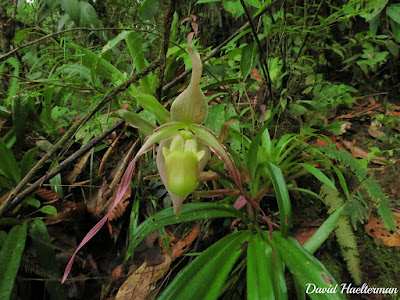Phragmipedium longifolium is found in Costa Rica, Panama, Colombia, Ecuador, Peru and Mexico. Its natural habitat is the moss-covered rocks and the banks along the streams or rivers in the mountain forests. It is located at an altitude of 600-2000 meters...
Phragmipedium longifolium also called as The Long-Leaf Phragmipedium, Cypripedium dariense, Cypripedium hincksianum, Cypripedium longifolium, Cypripedium longifolium var. gracile, Cypripedium reichenbachianum, Cypripedium reichenbachii, Cypripedium roezlii, Paphiopedilum hinksianum, Paphiopedilum longifolium, Paphiopedilum longifolium var. hincksianum, Phragmipedium dariense, Phragmipedium hincksianum, Phragmipedium longifolium f. album, Phragmipedium longifolium f. gracile, Phragmipedium longifolium f. minutum, Phragmipedium longifolium var. chapadense, Phragmipedium longifolium var. coloratum, Phragmipedium longifolium var. darienense, Phragmipedium longifolium var. gracile, Phragmipedium longifolium var. hincksianum, Phragmipedium longifolium var. splendidum, Phragmopedilum longifolium, Selenipedium dariense, Selenipedium gracile, Selenipedium hincksianum, Selenipedium longifolium, Selenipedium reichenbachii, is a species of the genus Phragmipedium. This species was described by Robert Allen Rolfe in 1896.
IDENTIFY PHRAGMIPEDIUM LONGIFOLIUM
Phragmipedium longifolium is found in Costa Rica, Panama, Colombia, Ecuador, Peru and Mexico. Its natural habitat is the moss-covered rocks and the banks along the streams or rivers in the mountain forests. It is located at an altitude of 600-2000 meters.
It is a medium to large sized, warm to cool growing terrestrial or lithophyte with very short stems with imbricate, distichous, conduplicate, leaf-bearing sheaths carrying several, linear-lanceolate, dark green above, pale green below, arcuate, acuminate, conduplicate from the middle to the base, up to 80 cm long, 1-5 cm wide leaves with the lower leaves being shorter than the rest.
The Long-Leaf Phragmipedium blooms on an erect, 60 to 90 cm long, pubescent, deep purple or green, terminal, to racemose, several flowered inflorescence that has 3 sterile, distichous, compressed, linear bracts with the 7 to 9 flowers opening in succession and occuring mostly in the fall but it is possible at almost any time of the year. The flowers are 20 cm in diameter. The dorsal sepal and petals are medium green heavily veined mahogany. The pouch is dark tan-brown to dark mahogany.
PHRAGMIPEDIUM LONGIFOLIUM CARE AND CULTURE
Cultural information should only be used as a guide, and should be to be adapted to suit you. Your physical location; where you grow your plants, how much time you have to devote to their care, and many other factors, will need to be taken into account. Only then can you decide on the cultural methods that best suit you and your plants.
Light:
Phragmipedium longifolium needs a light level of 18000-24000 lux. The direct rays of the sun are shielded. The recommended photoperiod is 12-14 hours.
Temperature:
This species prefers intermediate temperatures: daily temperature is 25 ° C and night temperature at 6 ° C.
Humidity:
The Long-Leaf Phragmipedium needs the air humidity of 80%, and must not fall below 70%.
Substrate, growing media and repotting:
Phragmipedium longifolium are usually grow in pot. As a substrate the mixture of medium-small-sized (1-2 cm) pine bark with sphagnum and perlite in the 2: 2 ratio is optimal. You can also add fern fibers, but it is not essential. As a vase I recommend using the transparent one: even if the roots of this orchid do not require light, it is much easier to control the substrate conditions. The repotting are carried out once every 1 - 1.5 years: being always wet, the substratum decomposes faster than usual and accumulates the salts harmful to the roots of the plant. The pH of the substrate must always remain around 6 - 6.5.
Watering:
It is a very needy species of water; for this reason the substrate must always remain wet. As soon as we see that it starts to dry out, it is necessary to water the plant.
Fertilizer:
This species is fertilized using 1/8 of the dose indicated on the vial of a suitable liquid fertilizer for orchids. The fertilizations are done every 3 weeks from April to October, and every 4-5 weeks in winter. Before fertilizing it is necessary to water it to avoid the harmful contact of the fertilizer with the dried roots.
Rest period:
In winter, it is possible to lower the winter temperatures a little but you never stop with the watering and do not lower the intensity of lighting.















I have one now for at least 20 years that blooms successively over an entire year with a 6 month rest in between. Potted in sphagnum and watered without stop, fertilized extremely weakly if at all, in a southwest window. Would love to post a picture if possible.
ReplyDeleteYou did a great job! Congrats! Love to see yours pics, pls contact me at https://travaldo.blogspot.com/p/contact-me.html
Delete